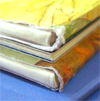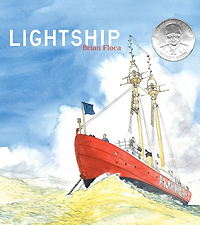|
|
|
|
|
|
|

| 최근 이 책을 구매하신 다른 회원의 책장 |
|
 |
|
|
|
[ 책 소개 ]
* A Robert F. Sibert Award 수상도서
* Cybil Award for Best Nonfiction Picture Book 수상도서
* An ALA Notable Children’s Book
* Booklist’s “Top of the List” Youth Picture Book for 2007
* Booklist Editors' Choice
* A New York Public Library 100 Titles for Reading and Sharing Selection
* A Banks Street Best Books of the Year selection
* A Junior Library Guild Premier Selection
* Buckaroo Book Award Master List
Locomotive로 Caldecott Medal상을 수상했으며, 과학, 역사, 지리, 자연 등 논픽션 그림책의 분야에서 최고의 명성을 얻고 있는 Brian Floca의 대표작입니다.
각종 선박들이 분주하게 다니는 뱃길 근처에 정박하여 등대의 역할을 하는 Lightship(등대선)은 일반인들에게는 잘 알려져 있지 않지만 선박들의 안전 운항을 위해 중요한 역할을 수행합니다.
이 책에서는 선장과 8명의 선원, 그리고 고양이 1마리가 탑승하고 있는 등대선 Ambrose호에서 무슨 일들이 벌어지고, 무슨 일들을 하는지를 사실적인 세밀화 그림을 통해 실감나게 보여줍니다.
이 책에 포함된 주요 내용은 아래와 같습니다.
- 등대선의 내부구조
- 등대선의 주요 장비와 시설
- 등대선 선원의 구성과 각자가 맡은 일
- 등대선에서의 선원들의 생활 모습
- 악천후에 대응하는 선원들의 노력
- 선박들이 안전운항할 수 있도록 빛과 소리를 이용해서 뱃길을 유도하는 등대선의 모습 등
큰 사이즈의 튼튼한 | 닫기x |  What is 하드커버? What is 하드커버?
양장본이라고도 불리우며, 표지가 단단한 판지로 만들어진 책입니다.
판지를 천이나 가죽으로 감싸기도 합니다. 책의 속지는 일반적으로 중성처리된 종이(Acid-free paper)를 사용해서 잘 변질이 되지 않기 때문에 오랫동안 보관하기에 적합합니다. 이 종류의 책은 더스트 재킷, 또는 더스트 커버로 불리는 표지덮개가 함께 있는 경우가 많습니다. 간혹 내부 속지가 콩기름 코팅이 된 경우 고약한 냄새가 나는 책도 있습니다.
|
[ 관련 동영상 보기 ]
 ▶
[ 서지 정보 ]
Hardcover: 48 pages
ISBN-10: 1416924361
ISBN-13: 9781416924364
책 크기: 26.1 x 23.8 cm
[ 영문 서평 ]
Book Description
You may never have
heard of a lightship.
Once, lightships
anchored on waters
across America,
on the oceans
and in the Great Lakes,
floating where lighthouses
could not be built.
Smaller than most ships,
but more steadfast, too,
they held their spots,
through calm and storm,
to guide sailors
toward safe waters.
In these pages
one lightship
and her crew (and cat)
again hold their place.
The crew goes
again from bow to stern,
from keel to mast,
to run their engines,
shine their lights,
and sound their horns.
They run the small ship
that guides the large ships.
They are the crew (and cat)
that work to make the ocean safe,
that hold their place,
so other ships can sail.
Come aboard!
School Library Journal *Starred Review*
Lightships were anchored where lighthouses could not be built. They protected our ocean harbors as well as points along the Great Lakes. The last one was decommissioned in 1983, so this fascinating picture book is a piece of nautical history. Floca's watercolor drawings depict daily life aboard one of these vessels, cooking, sleeping, working, all the while rolling with the rhythm of the waves. There were many hazards involved. Big ships came too close, anchors lost their mooring, and weather caused many problems. But when the fog rolled in, the lightship sprang into action. Lights flashed and horns sounded, allowing ship traffic to make it "through fog and night, past rocks and shoals, past reefs and wrecks, past danger." The drawings are very detailed. Some pages are collages of small scenes. Many are full spreads. The sailors' facial expressions are amusing to watch, and the resident cat appears on almost every page. The front and back endpapers show a cutaway view of one of the vessels. This fascinating, little-known slice of history should prove interesting to every child who loves big boats.
Booklist *Starred Review*
Lightships--floating lighthouses--were retired in 1983, but they live on in Floca's handsome picture book, which uses simple words and repeated phrases to emphasize the vessels' purpose and uniqueness as well as their day-to-day operation. "Here is a ship that holds her place," begins the text, which takes children on a sensory tour of the Ambrose, complete with the slapping of the waves on the hull, the rocking motion of the ship, the smell of the sea and of fuel, and--in one climactic blast that sends the ship's cat leaping straight up into the air--the sounding of the foghorn. Meanwhile, the ink-and-watercolor illustrations offer close-ups of the crew at work as well as wide, double-page scenes of passing ships (including the SS Ardizzone). Varied in composition and perspective, the art shows the little ship inside and out, in summer and winter, in calm and stormy weather. Some pictures include elements of humor, while other scenes are notable for their quiet beauty. Floca explains in an informative note that before it was possible to build platforms in deep water, lightships served as floating lighthouses, using powerful lights and blaring foghorns to signal other ships. From the endpapers, showing a cutaway view of the ship, to the final phrase, "the lightship holds her place," this handsome book respects both its subject and its audience.
Kirkus Reviews *Starred Review*
Floca creates both suspense and poetry in this tribute to the anchored lightships that once warned ships away from hazards on the North American coast. Beginning with, “Here is a ship that holds her place,” he introduces viewers to a crew of nine, plus a cat, then shows that crew performing routine tasks both topside and down below as they wait, but for what? When the weather worsens, that question is answered; on come the bright lamp and the deafening foghorn: “Then other ships sail safely,/because the lightship marks the way/through fog and night,/past rocks and shoals,/past reefs and wrecks,/past danger.” Using the Ambrose, a New York museum ship, as his model, the author presents an array of cutaways, views from above, glimpses of the engine room, john and kitchen, as well as showing the steadfast vessel floating on glassy seas and tossed by waves. Together, the pictures and the brief, measured text lend these utilitarian, no-longer-active vessels a heroic aspect that will resonate with all young fans of ships and the sea.
Publishers Weekly *Starred Review*
With straightforward, compelling prose and crisply detailed narrative ink drawings, Floca (The Racecar Alphabet) creates an engrossing portrayal of a now-vanished nautical practice (according to a closing author's note). "Here is a ship that holds her place," he begins, with a phrase that becomes the basis of an improvised refrain (e.g., "The lightship holds her one sure spot"). Thus he introduces the fictional lightship Ambrose and her nine-man crew. Floca follows the men and their marmalade cat mascot during the mundane tasks and sometimes-dramatic occurrences of daily life (a too-close-for-comfort encounter with a big tanker elicits a salty "#@*%&!" from the crew). In the final pages, a fog rolls in (as the cat creeps across the deck, for Carl Sandburg's fans), allowing the Ambrose to show off her raison d'être. She flashes her beacon and sounds her horn (with a mighty "beeooh," at which the feline visibly shakes) to "mark the way" for other ships "past rocks and shoals,/ past reefs and wrecks,/ past danger." Youngsters who are mesmerized by "how things work" books will want to add this one to their shelves, but even landlubbers may well embrace this tribute to steadfast duty on the high seas.
|
|
|
|
|
 |
제품상제정보 배송/반품/교환 안내 |
|
|
|
Super Buy 도서는 미국 출판사의 재고도서(Remainder Book), 초과출간도서(Excess Inventory), 할인도서(Bargain Books)
등을 직수입해서 정가의 55%~80%를 할인한 가격에 판매하는 제품입니다.
Super Buy 책의 품질은 거의 새 책과 같은
수준이지만, 간혹 커버의 스크래치나 접힘과 같은 하자나, 책 하단의 재고도서 마크가 있을 수 있습니다.
저렴하게 판매하는 Super Buy 제품의 특성상 반품이 되지 않습니다만, 파본인 경우에는 착불로 반품하시면 책값을
환불해드리거나 적립금으로 올려드립니다. (반품 전에 연락 요망)
하프프라이스북에서는 중고도서(second hand book)를 취급하지 않습니다.
|
|
|
 - 등록된 128,047건의 서평이 있습니다. - 등록된 128,047건의 서평이 있습니다.
| 더보기 
|
|
|
|
|
|
|
 |
|
|
|
|
|
|